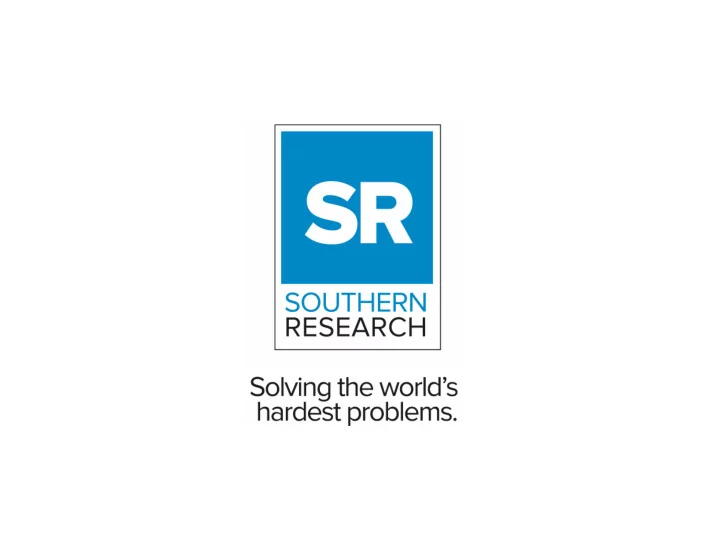

2016 ASME Power and Energy Conference Economic Study of a Novel Geothermal ThermoElectric Generation-plus-Membrane (G-TEG-M) System June 26-June 30, 2016, Charlotte Session 1-7-8 Advanced Technologies for CHP Systems 2 Kevin McCabe Southern Research
Abstract • Southern Research Ins1tute (SRI) and Novus Energy Technologies (Novus) are developing a novel Geothermal ThermoElectric Genera1on (G-TEG) system with integrated temperature driven membrane mineral concentra1on technology for use with low temperature geothermal brines. This Geothermal ThermoElectric Genera1on-plus-Membrane (G-TEG-M) concentra1on technology allows for electric power genera1on, clean water reclama1on, and brine concentra1on (with temperature driven membrane dis1lla1on) to efficiently recover valuable minerals from low temperature (<150°C) geothermal sources. This paper will study the limi1ng economic factors for this novel technology at a commercial scale. Variables such as geothermal brine throughput, mineral concentra1on thresholds, capital cost variance, and other cri1cal items have been studied to find the minimum selling price of the recovered minerals in a plant producing a 10% IRR.
Project Team Work performed with support from: US DOE EERE Award DE-EE0006746
Background Source: h\p://www.carbonneutral.com/carbon-offsets/geothermal-energy
Background (cont.) • Water is pumped underground and collected as steam or hot water. • The produced steam/hot water is used to generate electricity. • Wells with higher temperature (180-350°C) would use more efficient technologies and achieve >10-12% efficiency (highest reported 21%) • The collected water from the target injec1on wells is rich in minerals and is ~100-150°C • Could be used on slipstream of larger plant higher temperature plant.
Project Goals • Develop and validate a thermoelectric based power genera1on system that can achieve disrup1vely high conversion efficiencies from low-temperature resources (η>5.50% @ ∆T=100C), to economically produce baseload renewable electricity • Extract lithium from the filtered and concentrated brine to provide addi1onal system revenue and to increase supply for this cri1cal mineral
Process Flow Diagram
Block Flow Diagram
Water Research Center Infrastructure • Pilot coagula+on, floccula+on, sedimenta+on – 6 gpm Intuitech • Disc Filter – Amiad Spin Klin Arkal technology • Membrane Filtra+on – Vibratory Shear Enhanced Processing (VSEP) – Reverse Osmosis • Evaporator and Crystallizer – Encon evaporator - submerged electric heat exchanger – Sen1nel crystallizer – atmospheric or vacuum
WRC Treatability Tes1ng Infrastructure (con1nued) • Bioreactor pilot – Intuitech, 4 filter columns with associated feed equipment, 8 gpm • Adsorp+on tes+ng – using bioreactor columns • Filter press – Pac Press plate and frame, 100 psi – Space and u1li1es to bring in technologies for evalua1on • Pilot cooling tower • Ability to use power plant infrastructure – Flue gas for evapora1on – Various water streams
TEG technology 64 couple module fabricated with Novus hot pressed p- and n-type Bi2Te3 materials Development of 10x10cm unit which is 2.5x larger than standard units, producing >5.5% efficiency for Δ T > 100°C, at a cost of $0.40/wa\
Simulated Feed Geothermal Brines Low Strength Brine High Strength Brine (mg/L) (mg/L) Component Ca 22 400 - 460 Cl 1,800 7,000 - 14,000 Li 1 20 - 22 Mg 13 60 - 230 Na 900 3,400 - 7,000 Si 2 0 - 12 SO 4 63 380 - 400
Pro-forma Model • Includes construc1on of plant • Fixed and Variable opera1ng costs – Chemicals, U1li1es, O&M, G&A • Debt Service (10 years) – Equity contribu1on = 25% – Interest rate = 8% • IRR target = 10% • Current lithium selling price = $6600/ton • For purposes of this analysis, it is assumed that addi1onal surveying/inspec1on costs are incurred to base geothermal plant and not this mineral recovery plant.
Technical Baseline/Assump1ons • Plant size = 500 gpm • Inlet lithium concentra1on in brine = 28 mg/L • Inlet brine temperature = 150°C • Silica Removal = >80% • TEG efficiency = >5.5%
Analysis of Plant Size
Analysis of Brine Concentra1on
Analysis of Capital Construc1on Cost
World Lithium Produc1on & Reserves (1000’s of tons per year) Production Reserves 2013 2014 United States 870 W 38,000 Argentina 2,500 2,900 850,000 Australia 12,700 13,000 1,500,000 Brazil 400 400 48,000 Chile 11,200 12,900 7,500,000 China 4,700 5,000 3,500,000 Portugal 570 570 60,000 Zimbabwe 1,000 1,000 23,000 World Total (rounded) 34,000 636,000 13,500,000 W = Withheld proprietary information Baseline Plant (500 gpm – 28 mg/L) = ~ 80 tons/year lithium carbonate produc1on Source: USGS Mineral Commodity Sheet - Lithium
Applica1on Poten1al • According to USGS produced waters database 306 wells in the US have sufficient Li concentra1ons (>28 mg/L) for a 500 gpm plant – 135 geothermal – 167 conven1onal hydrocarbon – 4 other • The produced water database shows 10 states have Li concentra1ons greater than 28 mg/L with 4 states represented by geothermal well availability – Geothermal: California, Idaho, New Mexico & Texas – All: Ohio, Wyoming, New Mexico, Oklahoma, Texas, Alabama, Utah, California, Idaho, & Pennsylvania
Next Steps • Integrate en1re system for demonstra1on • Development of selec1ve rare earth element recovery • Develop be\er physics based predic1ve models of individual process components (analyze effect of brine temperature, effect of brine concentra1on on membrane life1me, etc.)
Conclusions • Sufficient lithium recovery is cri1cal for plant viability (higher brine Li concentra1ons, higher recovery needed, etc) • Produc1on would not saturate market (price stability) • Ample poten1al exists for deployment of technology
Acknowledgments • Co-Authors – Jay Renew, SR Water Research Center – Andy Muto, SR Energy and Environment – Tim Hansen, SR Energy and Environment • Department of Energy EERE
Thank You! Ques1ons?
Recommend
More recommend